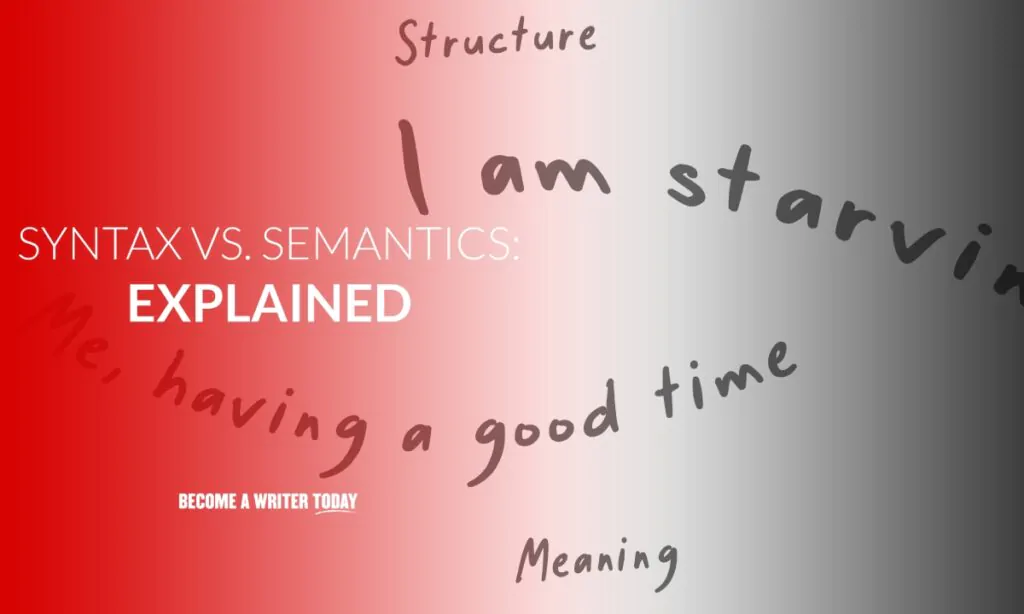The question of syntax vs semantics has long plagued readers and writers of the English language, but this guide will help you understand the differences fully.
In both the written English language and in the world of computer science, syntax vs semantics is an important distinction. Though these two grammar terms are similar, they are not the same. Understanding the difference will help you write well, following the rules of each.
We tested dozens of grammar checkers, and Grammarly is the best tool on the market today. It'll help you write and edit your work much faster. Grammarly provides a powerful AI writing assistant and plagiarism checker.
Contents
Syntax Vs Semantics: Defining Terms

Syntax and semantics are easily misunderstood because both terms refer to a set of words that help writers create valid sentences that readers understand.
Syntax refers to the set of rules that create sentence structure. Writers can also call these the grammar rules.
Semantics refers to the study of the meaning of sentences. Sometimes, grammatically correct words do not make sense, even when they are correct grammatically. Semantics helps add the layer of meaning so that words make sense.
A Close Look at Syntax

In natural language, syntax refers to the grammatical rules that dictate the structure of the sentence. These rules state that the subject typically precedes the predicate, adverbs describe adjectives, verbs and other adverbs, the overall grammatical structure of sentences and how words within sentences relate to each other.
Syntax also shows up in computer programming, and looking at this can make the rules more understandable in writing as well. Following the rules of syntax, a programmer can put code, or words, into a computer and create action. Computer programming language syntax involves three parts:
- Words – These words turn letters or characters into tokens the computer understands.
- Phrases – Phrases are the grammar rules that indicate how tokens come together to create meaning to the computer.
- Context – Computer syntax is never context-free, and the context of the language determines what the computer does with it.
Syntax rules are what allow a computer to read a phrase and understand what to do with the commands it contains. Syntax rules are what allow a reader to read written words and decipher meaning from them.
Syntax Rules Example
Syntax rules help written words make sense, for example:
- The room living the cat ran catch across to the mouse.
This sentence might as well be gibberish because it makes no sense. When the writer applies the rules of syntax and rearranges the sentence to read:
- The cat ran across the living room to catch the mouse.
It then makes sense. Syntax says where in the sentence the subject and verb go, how they must relate to one another and how the sentence, overall, clearly conveys meaning.
A Closer Look at Semantics
Semantics, on the other hand, involves the meaning of the words. This is where linguists come into play. Human language has meaning because of the way the reader interprets words, and that is what semantics addresses.
Semantics breaks down into two categories, which are:
- Lexical semantics – This refers to the meaning of words and the relationships between words.
- Phrasal semantics – This refers to the meaning of syntactic units larger than words, including phrases and sentences.
Because human language and English language are always evolving, semantics can change. The word “sweet” for example can mean both a flavor that is the opposite of savory and something that is amazing or awesome, depending on the context. Thus, semantics is rarely context-free, because the surrounding words in the phrase, sentence or paragraph have a direct impact on meaning.
Semantics Rule Example
Semantics is a little harder to show because it refers to meaning, but like syntax it does have some rules. A writer could say, “The cat chased the mouse.” and “The mouse chased the cat.” Both are grammatically correct. However, the rules of semantics affect the meaning of the sentence. Thus, these two sentences have highly different visual images they create.
Semantics and Syntax Must Work Together
Studying semantics and syntax is important because they must work together to create meaningful wring. The English language lexicon has so many words that writers have an infinite number of combinations they can make, but human language requires these combinations to have meaning.
The Final Word on Syntax vs Semantics
To write meaningful words, writers must combine syntax and semantics. The syntax of a language, whether it is English or any one of the different languages out there, provides the rules to structure the writing. The semantics of the language provides the meaning. Together, these two terms allow writers to write and convey meaning.
